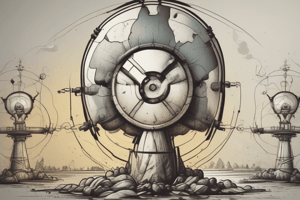Podcast
Questions and Answers
What is the classification based on to determine if a nuclear reaction is spontaneous or induced?
What is the classification based on to determine if a nuclear reaction is spontaneous or induced?
- Type of radioactive element involved
- Energy released during the reaction
- Formation of new element
- Whether the reaction takes place naturally or not (correct)
Which type of nuclear reactions involve a radioactive element spontaneously transforming into another element by emitting α, β, or γ-rays?
Which type of nuclear reactions involve a radioactive element spontaneously transforming into another element by emitting α, β, or γ-rays?
- Natural radioactivity reactions
- Artificial radioactivity reactions
- Induced nuclear reactions
- Spontaneous nuclear reactions (correct)
In artificial or induced radioactivity, what is observed when a stable non-radioactive element is bombarded with a suitable bombarding particle?
In artificial or induced radioactivity, what is observed when a stable non-radioactive element is bombarded with a suitable bombarding particle?
- Only stable elements are produced
- No new elements are formed
- Formation of unstable radioactive elements (correct)
- Radioactivity is observed
What is the term used for reactions where a stable non-radioactive element is bombarded and no radioactivity is observed?
What is the term used for reactions where a stable non-radioactive element is bombarded and no radioactivity is observed?
In induced nuclear reactions, what happens to the newly-formed element if it is stable or non-radioactive?
In induced nuclear reactions, what happens to the newly-formed element if it is stable or non-radioactive?
Which type of reactions are studied under 'Natural Radioactivity'?
Which type of reactions are studied under 'Natural Radioactivity'?
What can be observed in reactions under 'Artificial or induced radioactivity'?
What can be observed in reactions under 'Artificial or induced radioactivity'?
When a stable non-radioactive element is bombarded with a suitable particle, what type of reaction may occur?
When a stable non-radioactive element is bombarded with a suitable particle, what type of reaction may occur?
'Spontaneous nuclear reactions' involve which process?
'Spontaneous nuclear reactions' involve which process?
Flashcards are hidden until you start studying
Study Notes
Nuclear Reactions
- Nuclear reactions can be classified into two types: spontaneous and induced nuclear reactions.
Spontaneous Nuclear Reactions
- Occur naturally without any external influence.
- Involve radioactive elements disintegrating into another element by emitting α, β, or γ-rays.
- Examples: 238U → 234Th + α, 234Th → 234Pa + β
Induced Nuclear Reactions
- Occur when a stable element is bombarded with a suitable particle (e.g., neutron, proton, deuteron, α-particle).
- Result in the formation of a new element, which may or may not be stable.
- Examples: 27Al + 4He → 30Si, 14N + 4He → 17O
Characteristics of Induced Nuclear Reactions
- The newly formed element may be unstable or radioactive, leading to disintegration into a stable element.
- The new element may be stable and non-radioactive, with no disintegration observed.
- Examples: Unstable - 30Si → 30P + e+ (positron), Stable - 30Si (no disintegration)
Studying That Suits You
Use AI to generate personalized quizzes and flashcards to suit your learning preferences.




